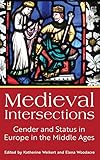Medieval Intersections : Gender and Status in Europe in the Middle Ages / ed. by Katherine Weikert, Elena Woodacre.
Material type: TextPublisher: New York ; Oxford : Berghahn Books, [2021]Copyright date: ©2021Description: 1 online resource (130 p.)Content type:
TextPublisher: New York ; Oxford : Berghahn Books, [2021]Copyright date: ©2021Description: 1 online resource (130 p.)Content type: - 9781800731547
- 9781800731561
- 305.42094 23
- online - DeGruyter
| Item type | Current library | Call number | URL | Status | Notes | Barcode | |
|---|---|---|---|---|---|---|---|
 eBook
eBook
|
Biblioteca "Angelicum" Pont. Univ. S.Tommaso d'Aquino Nuvola online | online - DeGruyter (Browse shelf(Opens below)) | Online access | Not for loan (Accesso limitato) | Accesso per gli utenti autorizzati / Access for authorized users | (dgr)9781800731561 |
Frontmatter -- Index -- Illustrations, Tables and Figures -- Preface -- Introduction: Gender and Status in the Medieval World -- Chapter 1 Mirrors for Margraves: Peter Damian’s Models for Male and Female Rulers -- Chapter 2 Inaudito exemplo: The Abduction of Romsey’s Abbess -- Chapter 3 The Corpus Christi Devotion: Gender, Liturgy, and Authority among Dominican Nuns in Castile in the Middle Ages -- Chapter 4 From Villainous Letch and Sinful Outcast, to “Especially Beloved of God” Complicating the Medieval Leper through Gender and Social Status -- Chapter 5 “To take a wyf” Marriage, Status, and Moral Conduct in “The Merchant’s Tale” -- Chapter 6 Objectification, Empowerment, and the Male Gaze in the Lanval Corpus -- Chapter 7 Pueri Sunt Pueri: Machismo, Chivalry, and the Aggressive Pastimes of the Medieval Male Youth -- Chapter 8 “And much more I am soryat for my good knyghts” Fainting, Homosociality, and Elite Male Culture in Middle English Romance -- Chapter 9 Wrist Clasps and Patriliny: A Hypothesis -- Index
restricted access online access with authorization star
http://purl.org/coar/access_right/c_16ec
Status and gender are two closely associated concepts within medieval society, which tended to view both notions as binary: elite or low status, married or single, holy or cursed, male or female, or as complementary and cohesive as multiple parts of a societal whole. With contributions on topics ranging from medieval leprosy to boyhood behaviors, this interdisciplinary collection highlights the various ways “status” can be interpreted relative to gender, and what these two interlocked concepts can reveal about the construction of gendered identities in the Middle Ages.
Mode of access: Internet via World Wide Web.
In English.
Description based on online resource; title from PDF title page (publisher's Web site, viewed 25. Jun 2024)


